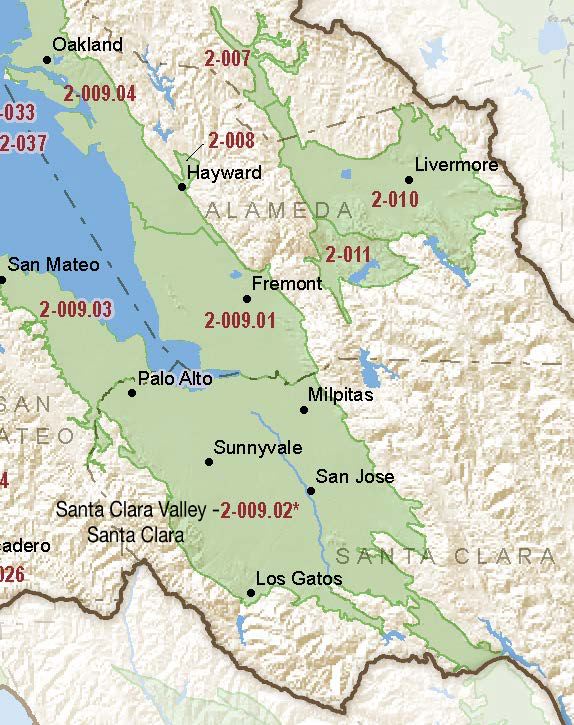Santa Clara Valley – Santa Clara
Statistics
- Basin Name
- Santa Clara Valley – Santa Clara
- Basin Number
- 2-009.02
- SGMA Basin Priority
- High
- Critically Overdrafted
- No
- Hydrologic Region Name
- San Francisco Bay
- Counties
- Santa Clara
- Adjacent Basins
At-A-Glance
Located in California’s San Francisco Bay hydrologic region, the Santa Clara Valley – Santa Clara is 189,581 acres in size. This High priority basin is home to an estimated 1,629,025 people (2010 value). It has approximately 1861 wells, of which approximately 233 are water supply wells. Groundwater accounts for approximately 50.76 percent of the basin’s water supply.

Basin Notes
2003: Bulletin 118 basin description
2016: Alternative to GSP filed with DWR
2018: Draft prioritization comment –
- Groundwater level decline: 1) CASGEM/WDL/GWIDS: Longterm hydrographs show groundwater level decline. Source: DWR 2) “A notable feature of the Santa Clara Valley Groundwater Basin is that the basin was overdrafted for decades, which induced land subsidence from Palo Alto to San Jose, as much as 13 feet in places. As a result, the lower reaches of streams and rivers reversed gradient such that tidal waters now invade inland as much as three miles upstream. Saline waters traveling up rivers and creeks have entered shallow aquifers and have, in turn, been drawn into the lower aquifers through pumping of irrigation wells screened in multiple zones and through abandoned wells. The SCVWD took several decisive steps to counteract overdrafting and land subsidence. These included expanding supply by erecting 11 local dams and using the stored water for groundwater recharge; building the infrastructure and securing the rights to import water from state and federal projects, as well as the city of San Franciscos Hetch Hetchy water supply; operating numerous groundwater recharge ponds and in-stream recharge with spreader dams; and aggressively sealing abandoned wells. These measures have succeeded in curtailing land subsidence since 1968 and the advance of saltwater intrusion, primarily since 1985. Source: A Comprehensive Groundwater Protection Evaluation for the South San Francisco Bay Basins, 2003 (South Bay Report), pg. 9
- Salt intrusion: 1) The groundwater quality in the Santa Clara subbasin is of good to excellent mineral composition and suitable for most beneficial uses. The groundwater meets all drinking water standards and can be used without additional treatment (SCVWD 2001, 2010). Some areas affected by historical saltwater intrusion exist in the northern portion of the Santa Clara subbasin in the Shallow Aquifer especially near areas of historical subsidence. Recent groundwater monitoring has indicated that seawater intrusion appears to be stabilizing (SCVWD 2012a). Source: LTOEISUSBRChapter72015, pg. 7-54 2) The Santa Clara Valley is located at the southern end of San Francisco Bay (fig. 111). Once devoted largely to agriculture, most of the land in the valley is now dedicated to industrial and urban uses. Population growth has resulted in a large water demand, which has exceeded the valley’s natural supply since the early 1940’s. Withdrawals of ground water in excess of recharge caused large water-level declines, which were followed by seawater intrusion and land subsidence surpassed in California only by that in the San Joaquin Valley. Since the 1940’s, importation of surface water has been essential to the control of these problems. Source: USGS GW Atlas 1995, pg. 7
- Subsidence: 1) Throughout the late 1800s and into the 1920s when two thirds of the Santa Clara Valley had been irrigated, water flowed freely from wells. Water-level declines of more than 200 ft occurred in the Santa Clara Valley from the early 1900’s to the mid 1960’s (Fowler, 1981). Land subsidence was first detected in 1933 (Poland and Ireland, 1988). As the decades passed, groundwater levels continued to decline and spirit-level surveys in 1967 identified subsidence of substantial magnitudeas much as 8 feetand areal extent. Source: U.S. Geological Survey (USGS)
This GSA has some alternative reporting elements. Click here to view the details. Subsidence: Case History No. 9.14. Santa Clara Valley, California, U.S.A., by Joseph F. Poland, U.S. Geological Survey, Sacramento, California Saltwater intrusion: Ground-water, salt-water infiltration, and ground-surface recession in Santa Clara Valley, Santa Clara County, California by C.F. Tolman and Joseph F.P. Poland, Stanford University, 1940
2018: Final Basin Prioritization: High
2019: Alternative to Groundwater Sustainability Plan approved by DWR
2024: Periodic review of GSP Alternative — Approval from DWR
